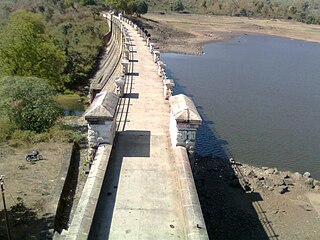Bengabad is a community development block that forms an administrative division in the Giridih Sadar subdivision of the Giridih district in the Indian state of Jharkhand.
Birni is a community development block that forms an administrative division in the Bagodar-Saria subdivision of the Giridih district in the Indian state of Jharkhand.
Deori is a community development block that forms an administrative division in the Khori Mahuwa subdivision of the Giridih district in the Indian state of Jharkhand.
Dumri is a community development block that forms an administrative division in the Dumri sub-division of the Giridih district in the Indian state of Jharkhand.
Gandey block is a community development block that forms an administrative division in the Giridih Sadar subdivision of the Giridih district in the Indian state of Jharkhand.
Gawan block is a community development block that forms an administrative division in the Khuri Mahua subdivision of the Giridih district in the Indian state of Jharkhand.
Giridih is a community development block that forms an administrative division in the Giridih Sadar subdivision of the Giridih district in the Indian state of Jharkhand.
Pirtand is a community development block that forms an administrative division in the Dumri sub-division of the Giridih district in the Indian state of Jharkhand.
Gobindpur is a census town in Govindpur CD block in Dhanbad Sadar subdivision of Dhanbad district in the Indian state of Jharkhand.

Topchanchi is a census town in Topchanchi CD block in Dhanbad Sadar subdivision of Dhanbad district in the Indian state of Jharkhand.
Dhanwar is a community development block that forms an administrative division in the Khori Mahuwa subdivision of the Giridih district in the Indian state of Jharkhand.
Purbi Tundi is a community development block that forms an administrative division in Dhanbad Sadar subdivision of Dhanbad district, Jharkhand state, India.
Topchanchi is a community development block that forms an administrative division in Dhanbad Sadar subdivision of Dhanbad district, Jharkhand state, India.
Baghmara is a community development block that forms an administrative division in Dhanbad Sadar subdivision of Dhanbad district, Jharkhand state, India.
Govindpur is a community development block that forms an administrative division in Dhanbad Sadar subdivision of Dhanbad district, Jharkhand state, India.
Dhanbad is a community development block that forms an administrative division in Dhanbad Sadar subdivision of Dhanbad district, Jharkhand state, India.
Baliapur is a community development block that forms an administrative division in Dhanbad Sadar subdivision of Dhanbad district, Jharkhand state, India.
Nirsa is a community development block that forms an administrative division in Dhanbad Sadar subdivision of Dhanbad district, Jharkhand state, India.
Tundi is a village in Tundi CD block in Dhanbad Sadar subdivision of Dhanbad district in the Indian state of Jharkhand.
Latani is a village in Purbi Tundi CD block in Dhanbad Sadar subdivision of Dhanbad district in the Indian state of Jharkhand.


